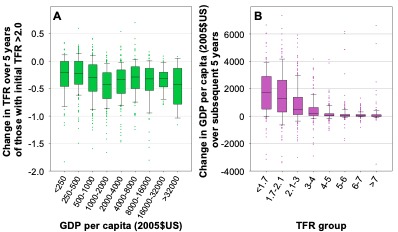Dr. Jane O’Sullivan clarifies seven common misperceptions
1. Misperception:
“There aren’t too many people. Most of the world is already below the fertility rate to maintain a stable population of c. 2.1. The only place that is well above that is Sub-Saharan Africa.“
Fact: The “replacement rate” fertility is nearer 2.08 in countries with low infant mortality, so the global fertility of 2.3 still sustains considerable growth.
2. Misperception:
“Fertility rates have been dropping dramatically. Globally, we went from 5.3 to 2.3 in just 60 years; currently, we are just barely over the maintenance rate.”
Fact: Global fertility rates have been decelerating sharply since the 1990s. Global fertility has barely fallen this century, and most high-fertility countries have not met the UN projection’s expectations of their fertility fall. That is why the UN projections keep being revised upward.
3. Misperception:
“There is no indication that fertility is going to do anything but continue to decline.”
Fact: There is a real possibility that global fertility could rise if the big high-fertility countries don’t reduce fertility as fast as their proportion of the global population is rising. I’m hopeful that they are starting to take population growth seriously and might start making progress, but this will be because people are acknowledging the threats posed by population growth, not because everything is doing fine on autopilot.
4. Misperception:
“The closest correlation to the fertility rate is the educational level attained by women—and that is increasing everywhere in the world.”
Fact: The relationship between education and fertility has been shown in several studies to be weak unless paired with strong family planning programs. The dramatic increase in girls’ education this century has been concurrent with stalls in fertility decline in many countries. The “closest correlation” is actually with family planning program efforts, which dropped dramatically from the mid-1990s.
5. Misperception:
“The greater risk of overshooting the current population projections is from a dramatic increase in how long people are living, not an increase in the fertility rate. So, is anyone proposing that we introduce a maximum on how long people can live?”
Fact: Increases in longevity have contributed to population growth, but that effect will be waning as the big gains in child mortality have already been had. The considerable uptick in excess mortality since the roll-out of mRNA vaccines might turn longevity trends around for a while.
6. Misperception:
“Richer countries have lower fertility rates, so lifting people out of poverty in developing countries will fix the population problem.”
Fact: This is mistaking correlation with causation. Income measures have not been found to be determinants of the rate of fertility decline, but high fertility is a very strong predictor of low or no growth in GDP per capita. By insisting that development will fix the population problem, people are not only dismissing the family planning programs that really drove the fertility decline, but they are also preventing those programs from enabling economic development.
In Figure 1 below, Chart A shows no relationship between income and the rate at which fertility fell, whereas Chart B shows high fertility but excludes the possibility of an increase in GDP per capita (the outliers in the top right corner are all Middle-East oil states in the 1970s and ’80s).

7. Misperception:
“Apocalyptists throughout the centuries have consistently been proved wrong because they underestimated the advance of technology. With the rate technology is increasing today, there is no way to predict the rate at which we will consume the Earth’s resources in the future.”
Fact: So far, technology improvements have not successfully staved off resource limits, as shown in many reports on critical mineral constraints, soil loss, aquifer depletion, pollinator disappearance, etc. Climate change is only one manifestation of humanity exceeding Earth’s limits. Several countries were on the brink of famine last year. There are more people suffering undernourishment, water scarcity, or violent conflict today than there were people in total in Malthus’ day.
Dr. Jane N. O’Sullivan is an Honorary Senior Research Fellow at the University of Queensland and a co-convenor of The Overpopulation Project. She has led international research on tropical subsistence and semi-subsistence farming systems, before shifting her focus to the threats posed by population growth to food security, economic development and ecological sustainability, and the efficacy of measures available to limit population growth. In this cross-disciplinary field, she has worked with ecological economists, environmental philosophers, demographers, and medical practitioners. She is also an executive member of Sustainable Population Australia and an expert adviser to the UK charity Population Matters.
The MAHB Blog is a venture of the Millennium Alliance for Humanity and the Biosphere. Questions should be directed to joan@mahbonline.org
The views and opinions expressed through the MAHB Website are those of the contributing authors and do not necessarily reflect an official position of the MAHB. The MAHB aims to share a range of perspectives and welcomes the discussions that they prompt.
